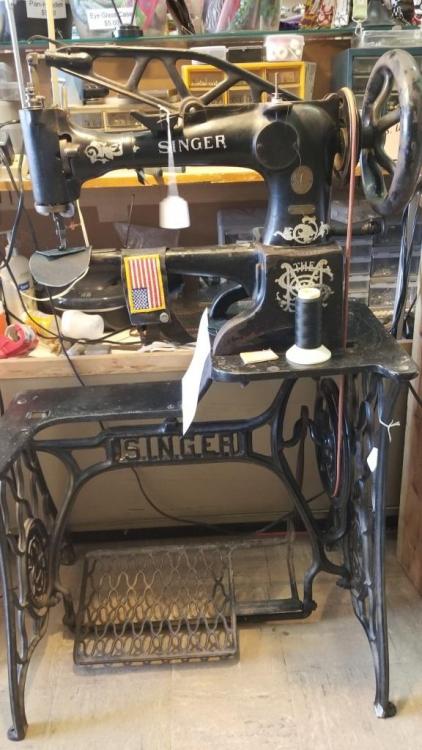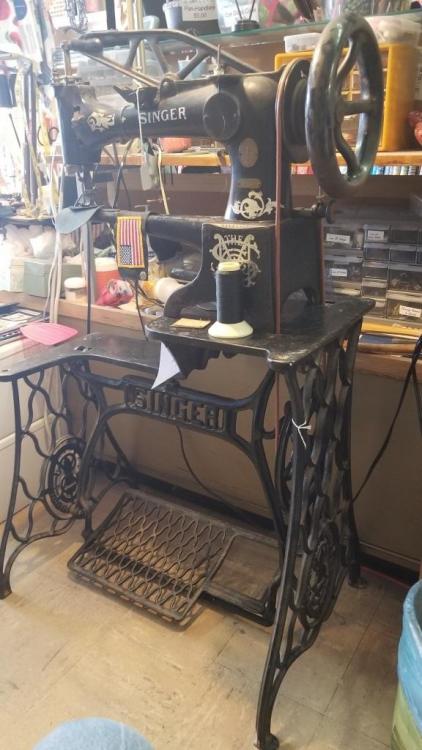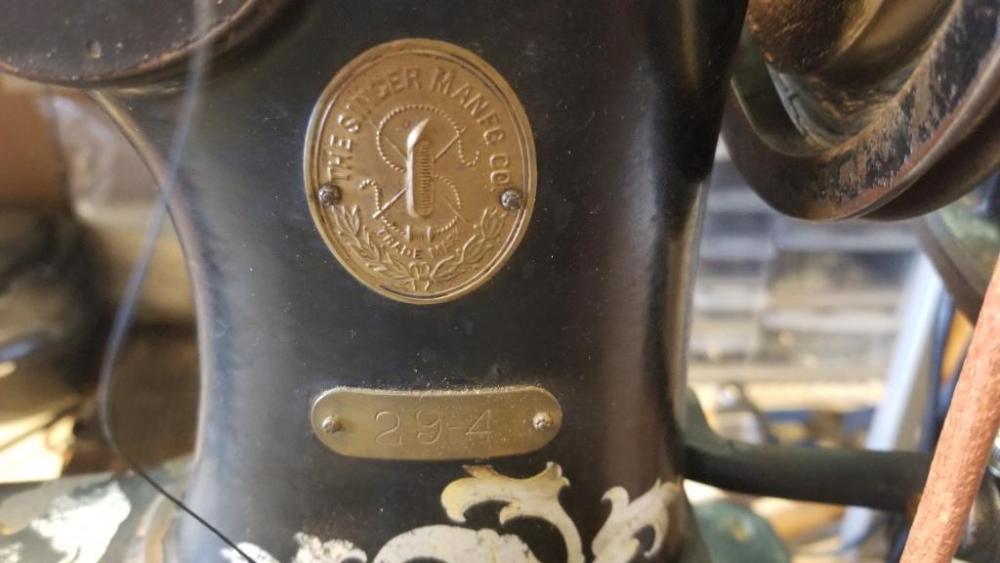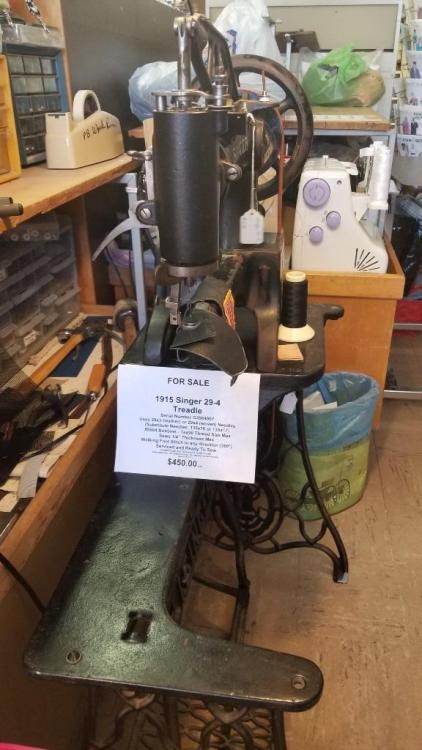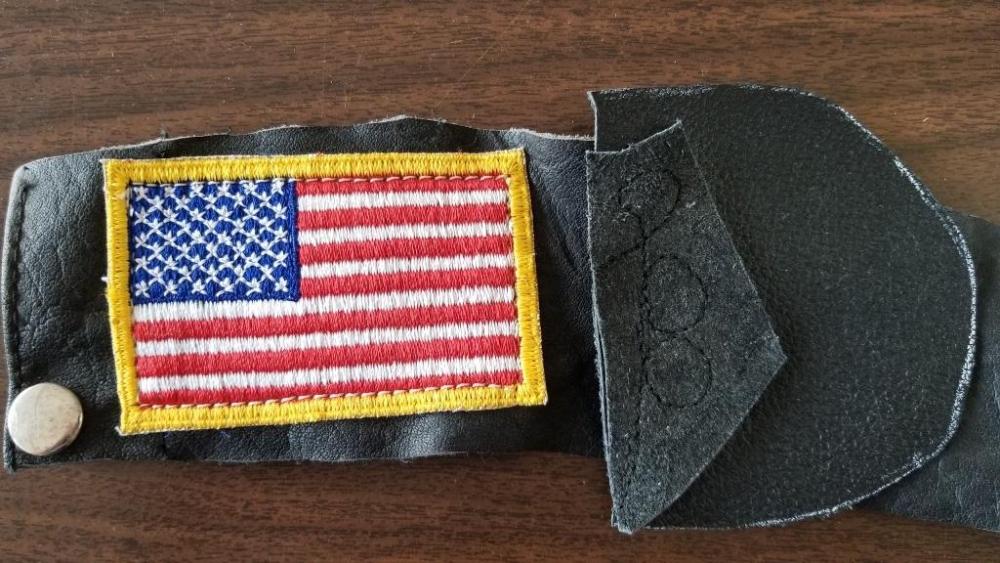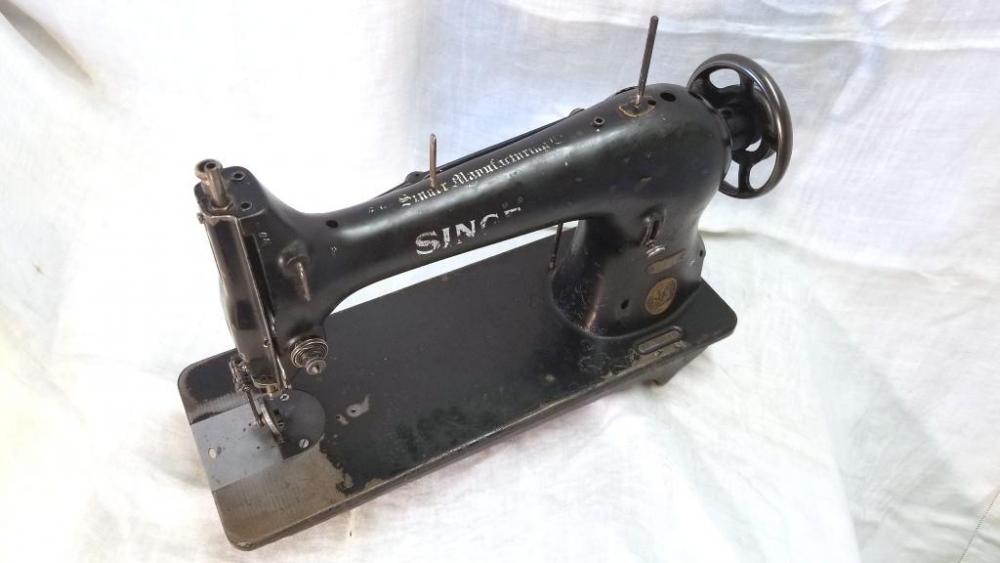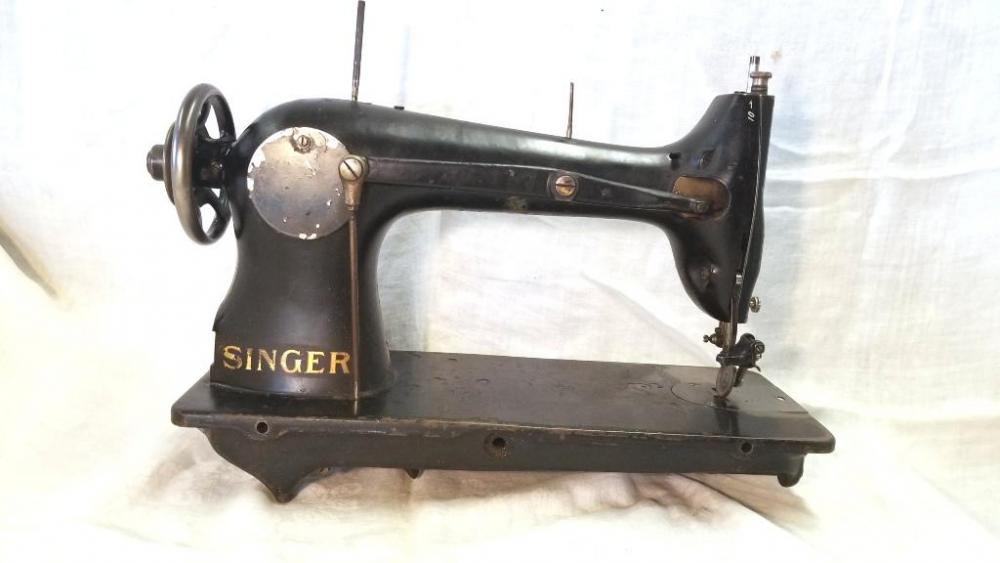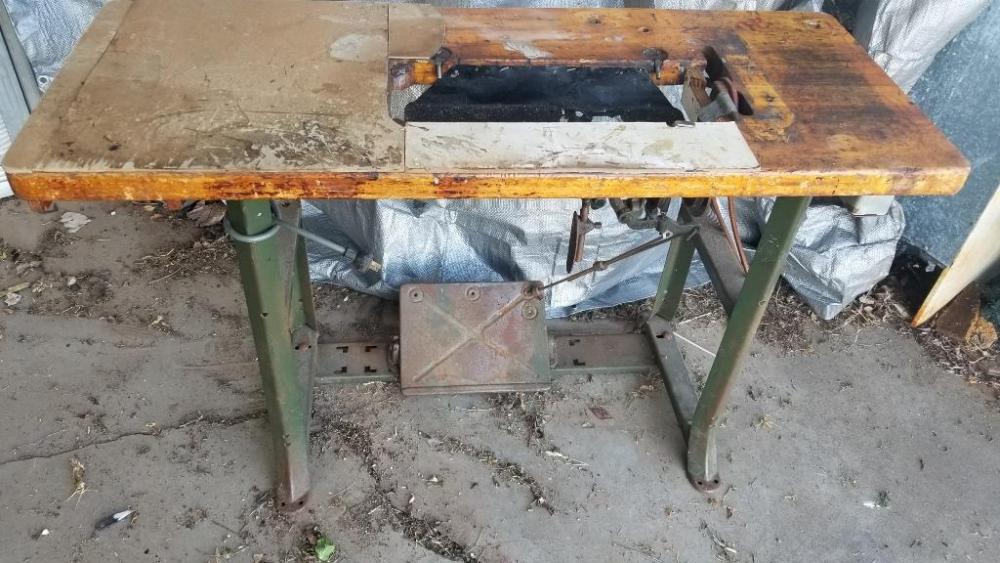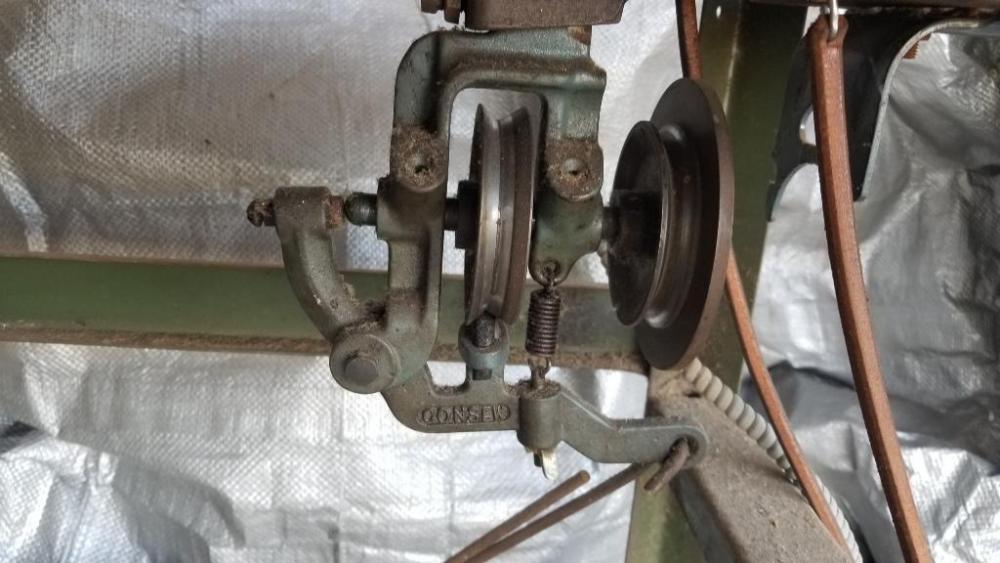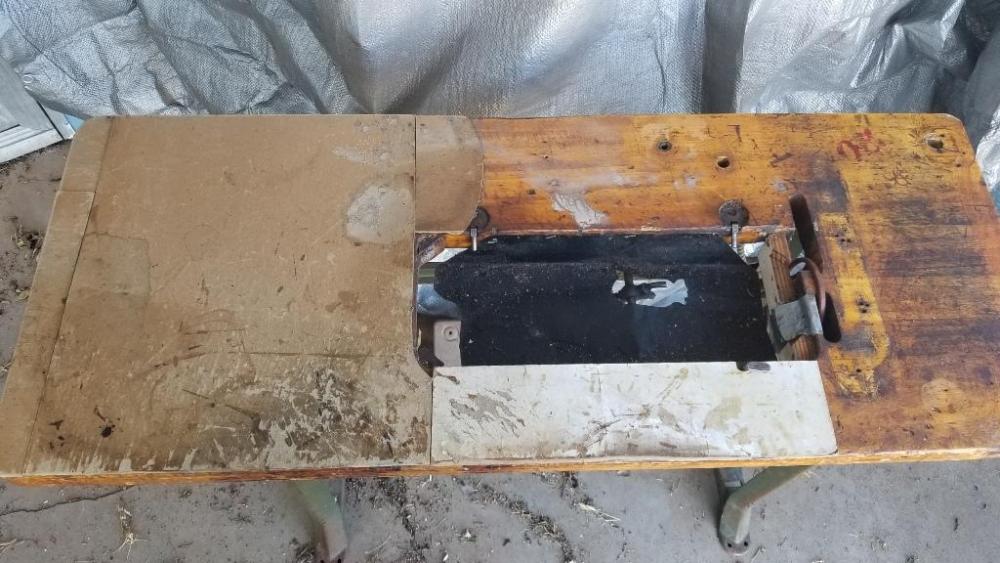-
Posts
483 -
Joined
-
Last visited
Content Type
Profiles
Forums
Events
Blogs
Gallery
Everything posted by cdthayer
-

Please give your opinion on my sewing machine purchase
cdthayer replied to Louiesdad's topic in Leather Sewing Machines
Thank you. Resewing that pool cover was an interesting project. The webbing was still good, and the mesh was still good, but all of the thread that stitched them together had failed or was failing. My hard work only lasted a couple of years, we found out. They told us that a whitetail doe deer decided to run across it one night, and before they finally got her out of the pool, she had torn it up beyond repair and they bought a new one. CD in Oklahoma -

Please give your opinion on my sewing machine purchase
cdthayer replied to Louiesdad's topic in Leather Sewing Machines
I use a 1944 Singer 111W153 for tarp, awning, pool cover work. (I nicknamed it “Ol Dirty” because the tarps that I work on (repairs) are always dirty.) It’s a compound-feed machine without reverse. I run Tex90 thread top and bottom, and the power stand that it runs in has a 3470 rpm clutch motor without speed reducer. I seldom run it wide-open (the max speed of the 111W153 is 2900 rpm), but I can run some thread through it quick before I have to stop and reposition the work. I had to resew three stitch lines on every piece of webbing reinforcement on a 30x60 used mesh pool cover once. I blew the sand out of the hook area with my air compressor several times, and like to drown it in Lily White Sewing Machine Oil. It’s amazing how much sand a mesh pool cover can have in it. The sewing went fast, but the unfolding, repositioning, and refolding like to wore me out. CD in Oklahoma -

Please give your opinion on my sewing machine purchase
cdthayer replied to Louiesdad's topic in Leather Sewing Machines
Now what in the world made you spell sew like that? (I ask myself that every once in a while with some of the words that I use.) CD in Oklahoma -
As an example of inflation, back around 1980 before I was making my own belts, I had a couple of belts made for my wife and I that had our CB handle names on the back. All hand-made with a floral pattern, cut-out letters in back with bright blue backing leather beneath, antiqued finish, and buckstitched with white lace. I think they cost me $40 each, which was sort of expensive for us at that time. I just ran the 1980 $40 amount through an online inflation calculator, and it said that $40 has become $131 in 2019. And don’t forget to figure in more labor cost now that everyone’s wages will be going up with the House of Representatives passing a $15/hour minimum wage for everyone this week. CD in Oklahoma
-
I think that inflation plays a large part in what carved and/or sewn leather should cost today compared to 60 years ago. I just don't know the answer to the actual cost comparison, unless you run the numbers through an online inflation calculator. That would require knowing exactly what an item sold for back then, and that may be hard to determine. I've not ever done that, but it might be interesting.... CD in Oklahoma
-

Please give your opinion on my sewing machine purchase
cdthayer replied to Louiesdad's topic in Leather Sewing Machines
Can you expand on that a little for me? You're saying that the Adler 205-370 came out in two different throat depths? CD in Oklahoma -
Maybe he noticed that it says "Singer" instead of "Simanco"? CD in Oklahoma
-
Aren't we all...... CD in Oklahoma
-
Could you make your own staples by bending wire and pre-punching the holes in the leather? I'm not sure what kind of wire you'd want to use. CD in Oklahoma
-
I forgot to add, that although we have PayPal for online payments, we also use SquareUp for on-site credit card payments. It used to be free for the gadget to go on a Smartphone to swipe cards, but we've had to buy the updated gadget that reads chips and swipes cards both. We like SquareUp and have used it for several years. I hear that PayPal may have a similar gadget for Smartphones now. CD in Oklahoma
-
That's probably the best thing you're doing at this point Kolton45. That one important question will tell you a lot about what the Buyer has in mind (or, if they're out of their mind). Some people who don't do crafts of any kind don't realize what is involved to make an item just to their specifications. The only other thing that I would mention, is to not let friendship determine who pays up front and who doesn't. Get a plan together on what gets paid when to avoid being left holding the bag for non-payers, and then stick with that plan for everyone. Friends included. Lots of friendships have been ruined because of what the friend is supposed to pay and when. CD in Oklahoma
-
Thanks for the information Gunnarsson. It’s interesting to get an idea of prices in your country/area. I agree that if you’re not going to use it much, the cost could be wasted money. I have a sewing shop where I do repairs, so my 29s have paid for themselves and earned a profit. Much of my sewing over the years couldn’t have been done without a 29-style machine. CD in Oklahoma
-
Care to expand on what "stupid money" (in your opinion) would be? CD in Oklahoma USA
-
I don’t know the history of this locally-found universal feed sewing machine, except that it was stored inside when I first saw it and has remained that way. It is serial number G3964907, and uses 29x4 or 29x3 needles and 8604 bobbins. It had been puttered with by someone (perhaps a child?) that removed many parts that could be removed without tools, including the shuttle. All parts have been replaced including a used genuine Singer shuttle and a new round leather drive belt. Maximum unassisted stitch length on embroidered patch over garment leather is 7-8 SPI (Stitches Per Inch) indicating obvious wear on a 100+ year old machine showing its age. The wooden pitman rod was missing and has been replaced with a used Singer wooden pitman rod. The stand is missing the parts drawer. The unit is serviced and ready to sew (outfitted with 29x3-18 needle & Tex90 thread top & bottom) and can be test-sewn prior to purchase. A threading wire is included. It is being stored inside my recently closed (May 2019) retail sewing shop. Price is $450US for the unit. All items are as-is, pickup only at my retail shop in downtown Frederick Oklahoma (USA) by appointment, no shipping. All sales are final. No returns, no warrantees. (Frederick is approximately 29 miles north of Vernon Texas, 20 miles from US Hwy 287, and approximately 67 miles NW of Wichita Falls Texas.) Please post questions to this thread or by PM. CD in Oklahoma
-
The previous owner of this Singer 31-15 flatbed sewing machine made billfolds in his home craft shop prior to having health problems. It is serial number AB480555, and uses DBx1 needles and 2996 bobbins. It is equipped with a Simanco #2203 roller presser foot, and it appears that he used Tex69 thread (had a Singer size 16 leather point needle in it). I oiled it and then hand-wheel test-sewed it briefly with Tex90 top and his (Tex69?) thread in the bottom, using a new Organ DBx1 110x18 regular point needle. Maximum unassisted stitch length on garment leather is 6SPI (Stitches Per Inch). It appears to be a good light-weight leather, canvas, or vinyl sewing machine. The older green H-leg power stand that it was in may be the same 1937 vintage as the machine, and has had some replacement sections put into the working surface. The hinges are screwed to the stand top instead of the common lift-out type. The clutch is an Atlas-type made by Consew that can be used with your choice of motor. The existing motor is non-working and off of the mounting. It’s a GE 1/3HP, 1725RPM motor with a 1/2” shaft that includes a flat area for a set screw. The old motor is included and has half of the clutch still mounted on it with 2 set screws. The head, motor, and drawer are being stored inside in my sewing area, and the stand is being stored outside covered on my carport. The table-mount bobbin winder is not mounted but included with the stand. Price is $160US for the machine head alone, $30US for the stand alone, or $190US for the pair. Take one or both. All items are as-is, pickup only at my home in Frederick Oklahoma (USA) by appointment, no shipping. All sales are final. No returns, no warrantees. (Frederick is approximately 29 miles north of Vernon Texas, 20 miles from US Hwy 287, and approximately 67 miles NW of Wichita Falls Texas.) Please post questions to this thread or by PM. CD in Oklahoma Additional photos of the stand:
-
Interesting. Thanks for the information. I have two Singer 29K70 machines and the one 29-4 (although none of them are in mint condition) and hadn't ever looked up what a new, unused Cowboy 29K was bringing. I know that I don't want to sell my 29K70 machines (one at the shop, one at home) because I use them for too many things and would certainly miss them. And now that I learn what a replacement 29K70 might cost me, I for sure want to hang on to them both. I bought my first 29K70 (complete with treadle stand) back in 2007 in Edmond Oklahoma for $176. It was delivered to Lawton Oklahoma for me. It still gets 6spi today. I picked up the second one (complete with treadle stand) in 2008 on a Craig's List Ad in Phoenix Arizona for $76 (it could stand to be rebuilt, 8spi but works fine for embroidered patches). My son was there and picked that one up for me. The Singer 29-4 (the only one that I've seen available in my area for 13 years) cost me $350 and had parts missing (anything that a 5-yearold could unscrew or pop off and lose was missing including the shuttle). After replacing the parts with Singer original parts and getting it adjusted to sew, I've got to ask what I thought was some real dollars for it (even though it needs rebuilt at 7-8 spi). My, how things have changed in a decade. CD in Oklahoma
-
One thing that you might consider is stating what the length of the longest stitch is in either mm or stitches per inch. That seems to be one of the most asked questions about patchers (to determine if they need rebuilt or not). Wow! I guess I need to load up my extra Singer 29-4 and haul it to Arlington Texas! (or did your account get hacked?) CD in Oklahoma
-
If there's oil coming out = good If there's no oil coming out = Bad CD in Oklahoma
-

Can you run a cowboy 3200 on an old singer treadle?
cdthayer replied to kyleboedeker's topic in Sewing Leather
I won’t argue with you guys that like motors, but I need to respond. I realize that there’s a lot of money to be made helping to sell the latest motors. The OP didn’t say what kind of sewing he would be doing with his handcrank 3200, but since it’s a handcrank, it sounds to me like he’s not going to be doing a bunch of production with it. One-offs, occasional-use projects, and repair work can work really well with manually-powered machines, even the so-called “heavy duty machines”. Just look at the Tippmann, the new Cowboy Outlaw, and the Hand Crank Outlaw 3200. It appears that hand-operated large-capacity sewing machines are gaining in popularity, or why would we be seeing new ones coming onto the market? Hand cranking a large machine is not for the squeamish, and if you don’t think it will work well for you, then you probably ought to pass on one, because you probably won’t have much luck with it. Mounting a handcrank machine into a treadle can just enhance the functionally of the machine. There have been a great number of stitches (even the “heavy duty” kind) sewn using manual machines in the past. I see no reason to not continue doing the same. I can use my manually-operated machines anywhere that I can move them to, and I don’t have to pay someone else each time that I use it ($ to the power company, or $ to the guy that sells me fuel for a generator). Less (someone mentioned Zen?) can actually be really better even in this day and age..... CD in Oklahoma -

My old Durkopp is driving me up the wall!
cdthayer replied to toxo's topic in Leather Sewing Machines
For what it's worth, I've had two machines that experienced a shredded thread at the needle problem. One is a Consew 225 compound feed machine. I ordered new left and right toe feet to work zippers, and while one pair worked just great, the other pair ended up with shredded and broken upper thread. Finally, I discovered that when the Chinese drilled the needle hole in the inner foot of this pair, they never went back to knock the burr off underneath from drilling the needle hole. There was a piece of slag under the foot in the thread groove that worked kind of like a thread cutter, but not as well. Once I knocked that piece of burr off, the foot has been working great. Two was recently with my old 1917 Singer 16-41 Jump-foot machine. Once I started getting shredded upper thread, and got to looking at things, I discovered that the inner foot that had been very close to the thread where it exited the needle had become even closer to the thread from use. The inner foot has a small hole for the needle to pass through, and had began rubbing the thread against the needle plate hole enough to shred the thread bad enough that one strand would break and start a "fuzz-back" in the needle until other strands would break and add to a massive bird-nest above the needle at the last thread guide. Once I realigned the center foot hole to match the needle plate hole, no more shredding. CD in Oklahoma -

Can you run a cowboy 3200 on an old singer treadle?
cdthayer replied to kyleboedeker's topic in Sewing Leather
Yes. Combine the two. With leather sewing, you'll probably use the hand crank on most things anyway, but if you get into a long run on something, the treadle will already be going along with the hand crank motion, and your feet can help keep the machine going without wearing your arm out. I treadle a Singer 20U zigzag machine. It's got lots of drag with the zigzag linkage, and I do a lot of hand cranking to get going, make short runs, and make turns, but when I have a long run, the treadle comes in very handy. With that said, I hand crank an Adler 205-64 and an Adler 205-370, but have not ever tried treadling either of them on an Industrial Singer 16" flywheel treadle. CD in Oklahoma -

Just ordered a hand crank CB3200!
cdthayer replied to kyleboedeker's topic in Leather Sewing Machines
Cranking out products at a Craft Show will definitely garner attention, but you may want to consider having a helper doing the actual sales of pre-produced items. You can stay busy answering questions from the lookers, but once they become buyers, let your assistant finish the sale. A manual sewing machine at a show is almost always a hit. It won’t make a buyer out of every passer-by, but most of them will notice your booth, if only just a little. It makes most of them feel like the price of admission (if there is one) was worth it to get to see crafts being produced right there in front of them. I packed handcrank and treadle machines to Quilt Shows and Craft Shows the past 13 years and cranked out quilt blocks while my wife did the selling (we have a retail fabric business). Watching the machine was mesmerizing to both young and old, and even gave Mom or Dad time to actually look at your items while a youngster’s attention was on the machinery. Keep on cranking. I’m a huge fan of manually operated sewing machines. CD in Oklahoma -
You and me both! I don't use prewound bobbins, so I don't have much experience with them. Thanks. CD in Oklahoma
-
For someone just starting out on wallets, I'd recommend an old Singer 31-15 with a roller foot to get into the sport. CD in Oklahoma
-
School me on bobbins Wiz. I have in my database that my 1944 Singer 111w153 and my 1959 Singer 111G156 that use bobbin #203470 (244750 aluminum) require size "G" bobbins. Am I out of whack on this? CD in Oklahoma




